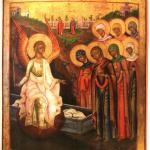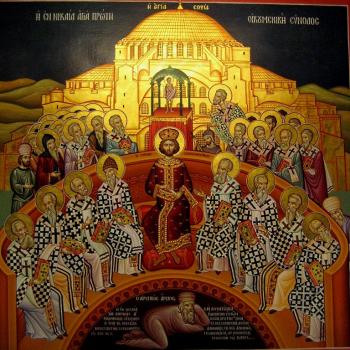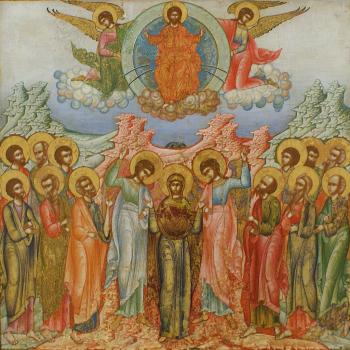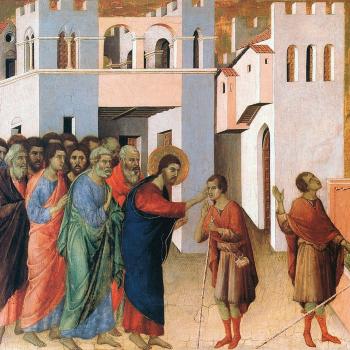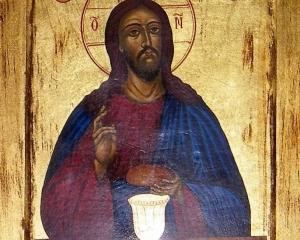
Naïve piety and superstition both cause great confusion concerning the eucharist, as we find those who follow one or the other, or both, think they can actually harm the body of Christ. Eucharistic sacrilege, the intentional dishonoring of Christ, does not harm Christ himself, but the person committing the abuse. On the other hand, when something accidental happens to the eucharistic bread, such as when it crumbles and someone steps on the crumbs, what Hugh of St. Victor said applies:
Do not be horrified that it happens sometimes, as it customarily happens, that you see some things take place in the sacrament which will seem to be unworthy. This is so in the evident appearance only. He shows you the appearance, He preserves the truth in Himself. He exhibits to your sense the likeness of the corporeal, that you sense in all things may be trained in its own. He preserves the truth of inviolable and immortal nature for His body, lest it be corrupted in its own. [1]
We must not confuse what appears to happen to what actually happens. What happens to the appearance of the bread and wine, to the physical accidents, do not happen to Christ himself:
He seems to be affected or sullied and He perseveres unviolated. He endures that these things be done about Him, lest our sense perceive something strange, but He does not receive these things in Himself, lest His incorruptible nature lose its purity. So great is the dignity and cleanness of Christ’s body that it can neither be affected by any corruption nor stained by sordidness. And so if at any time you see these things take place do not fear for Him but be solicitous for yourself. He himself cannot be injured, you can be harmed who can believe badly.[2]
When someone attempts some sort of blasphemy with the eucharist, such as in a Satanic Mass, we must not think they hold power over Christ. They cannot harm him. They cannot force him to act against his will. Their actions are done solely to the accidents, to the physical manifestation of bread and wine, not to Christ himself. As Hugh explained, nothing can harm him. In his resurrected glory, his body is incorruptible, indeed, it is no longer bound by mere physical laws because it has become a spiritualized body. He can, as we know, engage the physical reality through his body. As heaven merges with earth, so the physical reality still has a place with the glorified body, but the realization of that reality is in a new mode of existence. The glorified body no longer is bound by mere physical limitations, rather, such physical forms find themselves bound by the new spiritual reality established in Christ. What we perceive, what we typically experience, continues to follow the laws of nature, so that we see things happening to what appears to be mere bread and wine, occurring to them as would normally happen to bread and wine. This, of course, is not to say the eucharist is mere bread and wine, far from it, for it is the presence of Christ, the real and true presence of Christ, which is a spiritualized presence that incorporates and engages material reality but is not limited to or bound by it. “For we do indeed believe, “Lanfranc stated, “that the Lord Jesus is truly and salubriously eaten on earth by worthy recipients, and we most certainly hold that he exists in heaven uncontaminated, incorrupt, and unharmed.” [3]
As we eat Christ, we receive him, even as he receives us in communion; but in doing so we engage a spiritual reality, a reality which explains why material rules do not apply to communion. We receive the whole of Christ in either species, as well as in any portion of the species. No matter how much we seem to consume physically, we receive the same reality: the whole of Christ:
Thus the whole Host is the body of Christ in such a way that each and every separate particle is the whole body of Christ. There separate particles are not three bodies, but only one. Nor do the particles themselves differ among each other as if there were a plurality, since the one particle is of the whole body as the rest of them are that same body. [4]
When we naively think of the eucharist in a materialistic fashion, we misconstrue what it is. We must think of Christ in his resurrected glory, how he was able to move about in a way which overcame the expectations of physical reality. That should help us understand communion. Just as Jesus could be touched, if he wanted to be, or he could appear to go through closed spaces as if he were a ghost, so the reality of his spiritual body allows us to come in contact with and receive him into us (as he receives us into himself) through the means which he left for us, that is, through the eucharistic species which shows us that we receive him as spiritual food which holistically nourishes us. Thus, St. Albert the Great wrote:
Therefore, this bread refreshes [us] in three ways that it has in common with material food, and three ways that it has in common with spiritual food. For it refreshes from heavenly power and from the purity of its substance and from the principles of life which are in it, and it has these in common with material food. It also refreshes because it is the root of immortality, and because it has power to overcome and change others to itself, and because it is a general food for both soul and body. And it has these three in a special way, since it is a unique food, different from other foods.[5]
It is the spiritual nature of the resurrected body which confuses and confounds us. And yet, we must always keep in mind that this is what we are told will happen to us by St. Paul:
So is it with the resurrection of the dead. What is sown is perishable, what is raised is imperishable. It is sown in dishonor, it is raised in glory. It is sown in weakness, it is raised in power. It is sown a physical body, it is raised a spiritual body. If there is a physical body, there is also a spiritual body (1Cor. 15:42-44 RSV).
We know the resurrected body is the same body but in a new mode of being. We want to think of it either within the confines of mere materiality, which is what we are accustomed to when considering bodily existence, or as a pure spirit, which knows no materiality. But when we look at Christ, we see he has both, that he is capable of acting in the material sphere without being limited by it; this is how the eucharistic miracle should be understood. It is Christ working with the material sphere, through material means, the species of bread and wine, without being limited by the matter itself: he uses it, he transforms it, so that he becomes present but in a unique way, for he does so while preserving the physical form (the accidents) used. Why? Simply because we learn from the physical form that what we are consuming is a type of food, allowing us to understand that there is a special relationship between communion and eating (for by eating, we bring that which we need to live into ourselves, and through communion, we bring the author of life himself into our very being):
Thus the sacrament of the altar and the Divine Eucharist in the true body and blood of Our Lord Jesus Christ is an image according to the appearance of bread and wine, in which it is perceived, and the thing is according to the truth of its substance, in which it is there believed and perceived. [6]
While the presence is real, the presence is not to be confused with the physical form of bread and wine; in a way it is said to be “invisible” even though we receive that invisible presence through a very visible physical manifestation:
With this distinction, then, one should say that just as the consumption of material bread nourishes and sustains human flesh, so in a similar fashion does the invisible and spiritual body of Christ nourish and enliven the soul of the one who receives it worthily. [7]
This, then, explains why we must not become overwrought when we see accidental things happen to the physical species of bread and wine, because such accidents happen; they do not inflict any real harm to Christ himself. We are able to commune with him through the eucharist; when we eat the bread and drink the wine, our teeth do not cause any harm to him, likewise, if someone thought they could harm him by showing disrespect to the eucharist, all they do is harm themselves while Christ remains inviolate. Eucharistic abuse, when intentional, certainly is a concern, because of the bad intentions behind it. The concern then should be to the one who commits such sacrilege. However, if something unintentional happens at a liturgical service, we need not worry: Christ is fine, he remains glorified and unharmed.
[1] Hugh of Saint Victor, On the Sacraments of the Christian Faith.. trans. Roy J. Deferrari (Cambridge: The Medieval Academy of America, 1951), 313.
[2] Hugh of Saint Victor, On the Sacraments of the Christian Faith, 313.
[3] Lanfranc of Canterbury, On the Body and Blood of the Lord in Lanfranc of Canterbury: On the Body and Blood of the Lord & Guitmund of Aversa: On the Truth of the Body and Blood of Christ in the Eucharist. Trans. Mark G. Vaillancourt (Washington, DC: CUA Press, 2009), 62.
[4] Guitmund of Aversa, On the Truth of the Body and Blood of Christ in the Eucharist in Lanfranc of Canterbury: On the Body and Blood of the Lord & Guitmund of Aversa: On the Truth of the Body and Blood of Christ in the Eucharist. Trans. Mark G. Vaillancourt (Washington, DC: CUA Press, 2009), 104-5.
[5] St. Albert the Great, On the Body of the Lord. Trans. Sr. Albert Marie Surmanski, OP (Washington, DC: CUA Press, 2017), 142.
[6] Hugh of Saint Victor, On the Sacraments of the Christian Faith, 309.
[7] Lanfranc of Canterbury, On the Body and Blood of the Lord, 80.
Stay in touch! Like A Little Bit of Nothing on Facebook.
If you have liked what you read, please consider sharing it with your friends and family!


